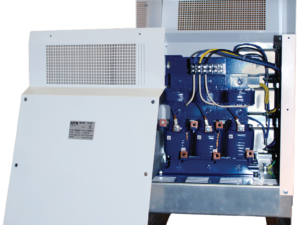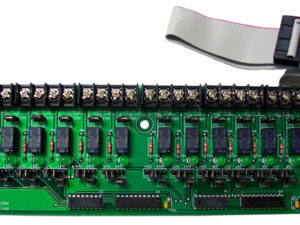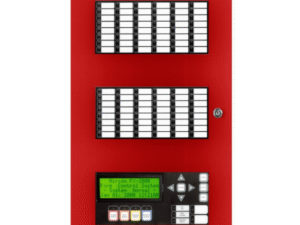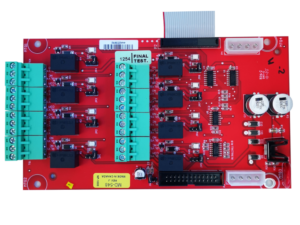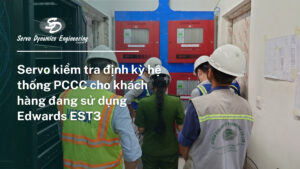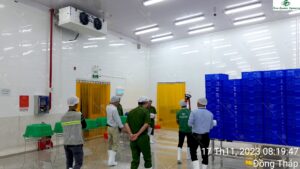Consulting, News, Solutions
Addressable Fire Alarm System: Structure, Benefits and Operating Principle
What is an Addressable Fire Alarm System?

An addressable fire alarm system is an intelligent fire detection system in which each device (smoke detectors, heat detectors, manual call points, etc.) is assigned a unique address on the signal loop connected to the control panel. Unlike conventional fire alarm systems, which only indicate fire alarms by zones, an addressable system precisely identifies the activated device’s location, enabling faster and more effective emergency response.
Smart Fire Alarm Systems represent the next evolution of addressable fire alarm technology. In addition to the features of an addressable fire alarm system, smart fire alarm systems integrate advanced functionalities such as:
- Internet Connectivity: Allows users to monitor and control the system remotely via computers.
- AI Integration: Uses artificial intelligence to analyze data and generate intelligent alerts, reducing false alarms.
- Automated Self-Testing: The system can automatically check the operational status of devices and notify users of any faults.
Classification of Addressable Fire Alarm Systems
By the Number of Loop Circuits
- Single-Loop Addressable Fire Alarm System: This system has a single signal loop connecting all devices.
- Multi-Loop Addressable Fire Alarm System: This system features multiple signal loops. For example, Mircom fire alarm panels can support up to 28 loops, with each loop accommodating up to 240 addressable devices.
By Connectivity Expansion Capability
- Expandable Addressable Fire Alarm System: This system allows for the addition of more fire alarm control panels as needed.
- Standalone Addressable Fire Alarm System: The fire alarm panel in this system operates independently and cannot connect with other fire alarm panels.
Structure of an Addressable Fire Alarm System

The components of an addressable fire alarm system include:
- Addressable Fire Alarm Control Panel (FACP): The brain of the system, responsible for receiving signals from input devices (detectors, manual call points), processing signals, and triggering alarms (via sirens, lights, or display screens). The control panel in an addressable system enables two-way communication with devices, allowing real-time monitoring of each component.
- Addressable Fire Detectors: Includes various types:
Includes the following types:
- Addressable Smoke Detector: Detects smoke in the air.
- Addressable Heat Detector: Detects abnormal temperature increases.
- Addressable Multi-Sensor Smoke & Heat Detector: Detects both smoke and heat.
- Addressable Multi-Sensor Heat & CO Detector: Detects abnormal temperature increases and hazardous CO gas.
- …
Each detector is assigned a unique address, allowing the control panel to precisely locate the activated device when a fire alarm is triggered.
- Addressable Manual Call Points: Allow users to manually trigger an alarm in case of an emergency. Each call point has a unique address.
- Addressable Modules: Used to integrate conventional (non-addressable) devices into an addressable system, such as conventional sirens, lights, or other peripherals.
- Signal Loop (Loop Wiring): Connects all devices to the control panel. Addressable systems typically use closed-loop wiring for higher reliability. If a segment is cut, the system can still function.
- Peripheral Devices: Includes alarm sirens, strobe lights, remote annunciators, event printers, etc.
Operating Principle of Addressable Fire Alarm Systems
An addressable fire alarm system operates based on two-way communication between the control panel and connected devices.
- Continuous Monitoring: The control panel continuously sends monitoring signals to each device on the loop to check their operational status.
- Fault Detection: When a fire-related event occurs (smoke, heat, flames, etc.), the corresponding detector identifies it and sends an alarm signal to the control panel, including its unique address.
- Processing and Alerting: The control panel receives the signal, accurately determines the incident location, and activates alarm devices (sirens, flashers, etc.) to notify occupants. The incident location is also displayed on the control panel screen or remote annunciators.
- Event Logging: The control panel records all system events, including alarm activation time, triggered device location, reset time, and more. This log is essential for incident analysis and system maintenance.
Example:
Suppose a small fire occurs in Room 305 of an office building. The addressable smoke detector installed in this room detects smoke and sends an alarm signal to the control panel, including its address (e.g., “Smoke Detector No. 12, Floor 3, Room 305”). The control panel displays this information on the screen and activates the fire alarm on the third floor, helping occupants evacuate quickly and allowing firefighters to locate the fire accurately.
Advantages of Addressable Fire Alarm Systems
Addressable fire alarm systems offer significant advantages over conventional fire alarm systems, especially in protecting lives and property. Here are the key benefits:
Accurate Fire Location Detection
Addressable fire alarm systems excel in precisely identifying the activated fire detection device (such as smoke detectors, heat detectors, or manual call points) and its exact location. This capability enables firefighters to quickly reach the affected area, saving time and minimizing damage to both people and property through early and effective fire suppression.
Minimized False Alarms
By distinguishing between genuine fire signals and interference, addressable fire alarm systems significantly reduce false alarms. This minimizes unnecessary panic and disruptions in daily operations, ensuring a stable and safe working environment.
Easy Maintenance and Management
These systems continuously monitor the status of each device, allowing for early detection of faults or malfunctions to ensure timely repairs. Additionally, the control panel logs events, making analysis and maintenance more efficient. With automated self-testing features, the system helps save time and costs associated with routine maintenance.
Flexible Scalability
Addressable fire alarm systems can be easily expanded or reconfigured to meet the evolving needs of a facility. This is particularly beneficial for large buildings or projects requiring system upgrades over time.
Integration with Other Systems
The system can integrate with other management systems, such as BMS (Building Management Systems), access control, and surveillance cameras, enhancing overall security and operational efficiency. This seamless connectivity improves facility management and response coordination.
Enhanced Safety
With its ability to detect fires early and accurately, an addressable fire alarm system significantly enhances safety for both people and property. Prompt detection and response help mitigate risks, minimize damages, and ensure optimal protection for buildings and occupants.
Comparison of Addressable Fire Alarm Systems and Conventional Fire Alarm Systems
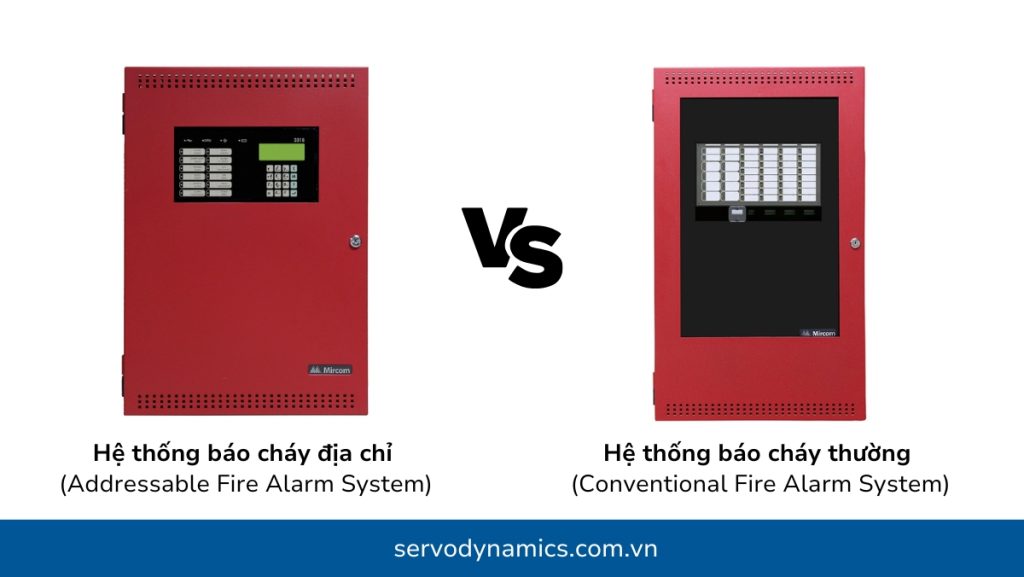
Addressable and conventional fire alarm systems are two widely used types of fire detection systems, each with its own features, advantages, and limitations. The choice between them depends on the scale, characteristics of the building, and the specific requirements of the investor. Below is a detailed comparison of these two systems:
Conventional Fire Alarm System: Divides the protected area into multiple zones. In case of a fire, the system triggers an alarm indicating that “a fire has occurred in Zone X,” but it does not pinpoint the exact device that activated the alarm.
Addressable Fire Alarm System: Each device in the system (smoke detectors, heat detectors, manual call points, etc.) is assigned a unique address. In the event of an incident, the device sends a signal to the control panel along with its address. The control panel accurately displays the exact location of the activated alarm device.
| Feature | Conventional Fire Alarm System | Addressable Fire Alarm System |
| Fire Location | Indicates fire by zone, unable to pinpoint the exact device. | Accurately identifies the activated device’s location (e.g., “Smoke detector #12, 3rd floor, Room 305”). |
| Accuracy | Low. | High. |
| Monitoring Capability | Monitors by zone. | Monitors each device individually, allowing early detection of faults or failures. |
| Maintenance | More challenging due to difficulty in pinpointing faults or failures. | Easier due to precise location tracking and event logging functions. |
| Scalability | Limited, difficult to expand or reconfigure. | Flexible, easily expandable or reconfigurable. |
| Integration | Limited integration with other systems. | Can integrate with systems like BMS, access control, surveillance cameras, etc. |
| Installation Cost | Usually lower. | Higher due to complex device configuration and installation. |
| Maintenance Cost | Can be higher in the long run due to troubleshooting challenges. | Potentially lower long-term due to automatic fault detection and monitoring. |
| Application Scope | Suitable for small and simple buildings with few rooms (e.g., residential houses, small shops, small offices). | Ideal for large, complex structures requiring high fire safety standards (e.g., high-rise buildings, shopping malls, hospitals, factories). |
| Reliability | Depends on zone quality. If one zone fails, others remain operational, but pinpointing fire locations is difficult. | Higher reliability with individual device monitoring and loop circuits that ensure continuity even if a cable is severed. |
| Programmability | Minimal programmability. | Advanced programmability allows customization of system functions and integration with other safety measures (e.g., controlling elevators, ventilation systems). |
Choosing the right fire alarm system requires careful consideration of these factors and should be guided by fire safety experts to ensure maximum safety and efficiency for your facility.
Addressable Fire Alarm System Installation Process
The installation of an addressable fire alarm system requires precision and adherence to technical standards to ensure optimal performance and safety. Below is the step-by-step installation process:
- Survey and Consultation: Assessing the facility’s condition and recommending suitable solutions.
- System Design: Creating design blueprints and selecting appropriate equipment.
- Equipment Installation: Installing the control panel, smoke detectors, manual call points, wiring, etc.
- Configuration and Programming: Setting up the system and assigning addresses to each device.
- Testing and Handover: Conducting system tests and finalizing handover with the client.
- Maintenance and Servicing: Performing periodic maintenance to ensure reliable operation.
Applications of Addressable Fire Alarm Systems
- High-rise Buildings and Office Towers: Precise fire location identification ensures quick response, preventing the fire from spreading.
- Shopping Malls and Supermarkets: Large areas with high foot traffic require accurate fire detection to avoid panic and chaos.
- Hotels and Hospitals: Ensuring the safety of guests, patients, and staff while minimizing property damage.
- Factories and Industrial Plants: Protecting production lines, warehouses, and corporate assets.
- Warehouses and Museums: Safeguarding valuable assets and historical artifacts.
- Airports and Train Stations: Ensuring passenger and staff safety while maintaining uninterrupted operations.
- Schools and Libraries: Protecting students, faculty, and educational resources.
- Other Public Facilities: Cinemas, theaters, convention centers, and more.
Top Addressable Fire Alarm Systems Brands
Currently, there are many brands on the market offering addressable fire alarm systems with varying quality and prices. Below are some well-known and trusted brands:
- Mircom (Canada): Specializes in fire alarm and emergency evacuation solutions. Products originate from G7 countries, meet NFPA standards, and are UL & FM certified.
- Notifier (USA): One of the top brands in fire alarm systems, offering comprehensive solutions for various types of buildings.
- Simplex (USA): Renowned for its advanced and intelligent fire alarm systems.
- Siemens (Germany): A globally recognized brand known for high-tech products, including addressable fire alarm systems.
- Hochiki (Japan): A long-established and reputable brand, known for its high quality and durability. Hochiki products are widely used worldwide.
- Honeywell (USA): A multinational technology corporation providing integrated fire protection and security solutions.
Important Considerations When Selecting and Using Addressable Fire Alarm Systems
- Choose a reputable supplier: Ensure they have experience and certifications in the fire protection industry.
- Ensure device quality: Select genuine products with clear origins that comply with standards.
- Design an appropriate system: Ensure the system meets the needs and characteristics of the building.
- Proper installation: Ensure stable and effective system operation.
- Regular maintenance: Conduct maintenance as recommended by the manufacturer.
- Comply with fire safety regulations: Ensure the system adheres to legal requirements.
Servo Dynamics – Authorized Distributor of Mircom in Viet Nam

Why Choose Us?
- Genuine, High-Quality Products: We are committed to providing only genuine products from Mircom and Edwards, ensuring quality, clear origin, and full certification.
- Comprehensive Solutions: Beyond equipment distribution, we offer a full-service package, including consulting, system design, installation, maintenance, and servicing, helping customers save time and costs.
- Professional Team: Our engineers and technicians are well-trained and highly experienced in addressable fire alarm systems, ready to support customers at every stage.
- Extensive Network: With branches in Ho Chi Minh City, Hanoi, and Da Nang, we provide fast and convenient nationwide service.

 Tiếng Việt
Tiếng Việt

